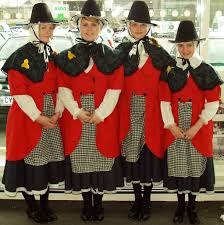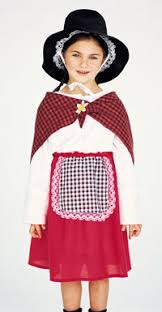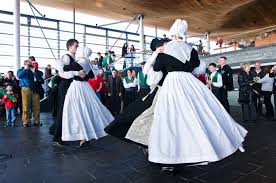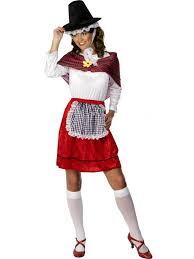source(google.com.pk)
Welsh Traditional Dress Biography
The popular image of Welsh 'national' dress, of a woman in a red cloak and tall black hat, is one which largely developed during the nineteenth century. It was part of a conscious revival of Welsh culture during a period when traditional values were under threat.
The costume regarded as national dress is based on clothing worn by Welsh countrywomen during the early nineteenth century, whch was a striped flannel petticoat, worn under a flannel open-fronted bedgown, with an apron, shawl and kerchief or cap. Style of bedgown varied, with loose coat-like gowns, gowns with a fitted bodice and long skirts and also the short gown, which was very similar to a riding habit style.
The hats generally worn were the same as hats worn by men at the period. The tall 'chimney' hat did not appear until the late 1840s and seems to be based on an amalgamation of men's top hats and a form of high hat worn during the 1790-1820 period in country areas.
Lady Llanover, the wife of an ironmaster in Gwent, was very influential in encouraging the wearing of a 'national' dress, both in her own home and at eisteddfodau. She considered it important to encourage the use of the Welsh language and the wearing of an identifiable Welsh costume. She succeeded in her aim mainly because people felt that their national identity was under threat and the wearing of a national costume was one way to promote that identity.
A further influence was the work of artists producing prints for the rising tourist trade, which had the effect of popularising the idea of a typical Welsh costume, and later the work of photographers who produced thousands of postcards. This contributed to the stereotyping of one style of costume, as opposed to the various styles which were worn earlier in the century.
Is there such a thing as a Welsh kilt?
Although Lady Llanover created 'a weird and wonderful' costume made for her court harpist (see photograph), she was not particularly concerned with a national costume for men. As a result, Welsh men do not have a national dress, although attempts have been made in recent decades to 'revive' a Welsh kilt which never in fact existed!
Even in Scotland, there is evidence to show that the kilt as we know it today is a comparatively modern development from the belted plaid, which was a more substantial garment worn across the shoulder.
Shawls
Shawls were the most fashionable of accessories between 1840 and 1870. The most popular were the Paisley shawls whose pattern originally came from Kashmir in India.
At first plain shawls with a woven patterned border attached were the most common. Later many fine examples with allover and border patterns were woven in Norfolk, Scotland and Paris. Shawls of the middle of the century were very large and complemented the full skirts of the period. Shawls were made in other fabrics and patterns, including Cantonese silk and fine machine lace, though it was the paisley pattern which became very popular in Wales along with home-produced woollen shawls with checked patterns.
In later years, although fashionable women no longer wore shawls, smaller shawls were still made and worn by countrywomen and working women in the towns. By the 1870s, cheaper shawls were produced by printing the designs on fine wools or cotton. Even during the early years of the twentieth century woollen, knitted and paisley shawls were widely worn in rural Wales. The paisley shawl even became accepted as part of 'Welsh' costume, though there is nothing traditionally Welsh about it at all.
One tradition of shawl wearing which is truly Welsh is the practice of carrying babies in a shawl. Illustrations showing this have survived from the late eighteenth century when Welsh women wore a simple length of cloth wrapped around their body. When shawls became popular, they were adapted to the same use, and some women even today still keep up the tradition.










Welsh Traditional Dress Biography
The popular image of Welsh 'national' dress, of a woman in a red cloak and tall black hat, is one which largely developed during the nineteenth century. It was part of a conscious revival of Welsh culture during a period when traditional values were under threat.
The costume regarded as national dress is based on clothing worn by Welsh countrywomen during the early nineteenth century, whch was a striped flannel petticoat, worn under a flannel open-fronted bedgown, with an apron, shawl and kerchief or cap. Style of bedgown varied, with loose coat-like gowns, gowns with a fitted bodice and long skirts and also the short gown, which was very similar to a riding habit style.
The hats generally worn were the same as hats worn by men at the period. The tall 'chimney' hat did not appear until the late 1840s and seems to be based on an amalgamation of men's top hats and a form of high hat worn during the 1790-1820 period in country areas.
Lady Llanover, the wife of an ironmaster in Gwent, was very influential in encouraging the wearing of a 'national' dress, both in her own home and at eisteddfodau. She considered it important to encourage the use of the Welsh language and the wearing of an identifiable Welsh costume. She succeeded in her aim mainly because people felt that their national identity was under threat and the wearing of a national costume was one way to promote that identity.
A further influence was the work of artists producing prints for the rising tourist trade, which had the effect of popularising the idea of a typical Welsh costume, and later the work of photographers who produced thousands of postcards. This contributed to the stereotyping of one style of costume, as opposed to the various styles which were worn earlier in the century.
Is there such a thing as a Welsh kilt?
Although Lady Llanover created 'a weird and wonderful' costume made for her court harpist (see photograph), she was not particularly concerned with a national costume for men. As a result, Welsh men do not have a national dress, although attempts have been made in recent decades to 'revive' a Welsh kilt which never in fact existed!
Even in Scotland, there is evidence to show that the kilt as we know it today is a comparatively modern development from the belted plaid, which was a more substantial garment worn across the shoulder.
Shawls
Shawls were the most fashionable of accessories between 1840 and 1870. The most popular were the Paisley shawls whose pattern originally came from Kashmir in India.
At first plain shawls with a woven patterned border attached were the most common. Later many fine examples with allover and border patterns were woven in Norfolk, Scotland and Paris. Shawls of the middle of the century were very large and complemented the full skirts of the period. Shawls were made in other fabrics and patterns, including Cantonese silk and fine machine lace, though it was the paisley pattern which became very popular in Wales along with home-produced woollen shawls with checked patterns.
In later years, although fashionable women no longer wore shawls, smaller shawls were still made and worn by countrywomen and working women in the towns. By the 1870s, cheaper shawls were produced by printing the designs on fine wools or cotton. Even during the early years of the twentieth century woollen, knitted and paisley shawls were widely worn in rural Wales. The paisley shawl even became accepted as part of 'Welsh' costume, though there is nothing traditionally Welsh about it at all.
One tradition of shawl wearing which is truly Welsh is the practice of carrying babies in a shawl. Illustrations showing this have survived from the late eighteenth century when Welsh women wore a simple length of cloth wrapped around their body. When shawls became popular, they were adapted to the same use, and some women even today still keep up the tradition.
Welsh Traditional Dress
Welsh Traditional Dress
Welsh Traditional Dress
Welsh Traditional Dress
Welsh Traditional Dress
Welsh Traditional Dress
Welsh Traditional Dress
Welsh Traditional Dress
Welsh Traditional Dress
Welsh Traditional Dress
Welsh Traditional Dress
No comments:
Post a Comment